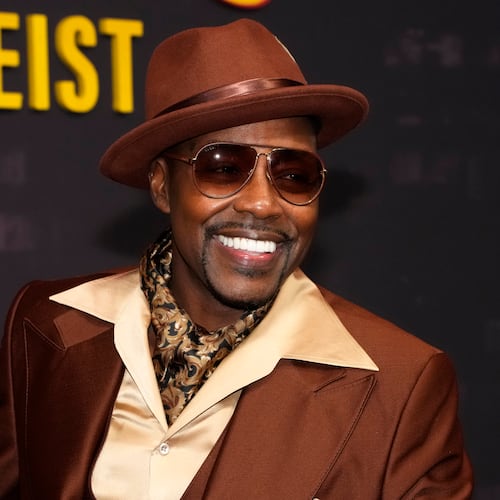James Brown was more than a captivating, gutsy, groundbreaking musician. He was an entrepreneur, a civil rights activist and an inspiration for millions.
The longtime Augusta resident was also deeply flawed, a man who was built on personal and societal trauma, battled drugs and the IRS and ended up in prison twice.
Seventeen years after Brown’s death at age 73, Atlanta filmmaker and director Deborah Riley Draper crystallized the many facets of the legendary singer into a four-part documentary on A&E called “James Brown: Say It Loud,” which airs over two nights Monday, Feb. 19 and Tuesday, Feb. 20.
“He liberated the thinking of people who were oppressed,” Draper said in an interview Monday with The Atlanta Journal-Constitution. “He made people want to dream.”
Mick Jagger and Questlove, huge James Brown fans, served as executive producers on the project. They, along with the likes of LL Cool J, Chuck D, Atlanta producer Dallas Austin and Rev. Al Sharpton, voiced their admiration for Brown’s innovation, resilience and self-determination.
“James Brown is a reflection of the Black experience in the context of the United States of America,” said David Wall Rice, professor of psychology at Morehouse University in the opening minutes of the special. “That’s why James Brown’s story is an American story.”
The documentary features three of Brown’s children, his former tour manager and musicians who worked with him, such as Bootsy Collins and Martha High. (Among the expert voices: AJC freelance writer Christopher Daniel, also a Morehouse adjunct professor and ethnomusicologist.)
Both Deanna and Dr. Yamma Brown, his daughters, talked to Draper about the good times as well as how he would physically abuse their mom.
“I thought it was critically important that Deanna and Yamma set the record straight on who he was in their own words with clarity and authenticity,” Draper said.
At the same time, she added, “Their love for their dad is incredible. I love the fact they have continued his legacy through the James Brown Academy of Musik Pupils in August to train young kids to love music and share their gifts the way their father did.”
Credit: A&E
Credit: A&E
Draper dug through hours of interviews and never-before-heard studio outtakes of Brown and used his voice to frame the narrative. Brown at one point distilled his philosophy into four words: “Be like nobody else.”
Besides inventing funk, he was an early adherent of the live album. His 1963 “Live at the Apollo” LP was his first smash album and greatly expanded his fan base. He surrounded himself with a coterie of talented musicians, a system of sorts Prince copied in the 1980s. He was able to make political statements as well as turn on the “Sex Machine” when the mood struck him.
What Draper admired was his consistency through the decades, primarily his push for Black folks to be independent and to carve their own path in the face of resistance. His one regret was dropping out of school early, she said.
“He firmly believed in education,” she said. “That’s why he dropped a track, ‘Don’t be a Dropout.’ He understood part of his deficit was his seventh-grade education. As confident as he was in business dealings, he couldn’t always protect himself or his brand from bad accountants and finance managers.”
While doing her research, Draper found a 1969 Look magazine profile that asked a provocative question: “Is James Brown the most important Black person in America?”
“That made it clear to me that there was more to Brown than his music,” Draper said.
This was a year after his incredible Boston concert the night Martin Luther King Jr. was assassinated. It aired live on Boston TV and through his words and actions, he helped prevent Blacks in that city from rioting the way they did in other cities.
He was one of the first Black entertainers to fly private jets and own multiple businesses including restaurants and radio stations. For a time, he even launched his own James Brown trading stamps, which Black businesses could redeem. “It was the Black cryptocurrency of the 1960s,” Riley said. “I couldn’t believe he did that. They are now in museums and people sell them on eBay.”
Brown’s quixotic embrace of Richard Nixon, who promised to help Brown build Black entrepreneurship, was viewed at the time as terrible optics, but Draper said it showed his power to be able to enter the White House “and speak his piece” to Nixon’s face.
What she admired the most about Brown was his tenet “Say it loud,” which is why she included it in the documentary title.
“He reminded us that we all have a voice,” she said. “We should speak our minds and be strong in our convictions about what’s right. People may want to dismiss us but we won’t be dismissed. That’s the lesson from James Brown from heaven to me.”
The fourth episode explores Brown’s influence on hip-hop. He has been sampled tens of thousands of times. Many key early hip-hop records featuring his beats include LL Cool J’s “Mama Said Knock You Out,” Public Enemy’s “Fight the Power,” Run DMC’s “Run’s House” and “I Ain’t No Joke” by Eric B. & Rakim.
“I think James Brown really was the architect of hip-hop,” said producer Jimmy Jam in the episode. ‘Hip-hop was built on those grooves.”
“We stand on James Brown’s shoulders,” said LL Cool J in the doc.
One Brown sample Draper wasn’t even aware of until she did the documentary: the silky, sexy Janet Jackson 1993 hit “That’s the Way Love Goes” uses parts of “Papa Don’t Take No Mess.”
‘That’s one of my favorite songs in the world!” Draper said.
A&E last week held a premiere of the documentary at the Apollo Theatre in Harlem, where Brown performed many times over the decades. In 1968, Draper’s mother Janette Coleman Riley travelled from Savannah to New York City to see Brown at that theater with Draper’s aunt Hazel Coleman. Her mom raved about that experience until her death in 2008.
“Being in that same building 50-plus years later was pretty crazy and surreal,” Draper said “I know my mom and aunt were up there dancing with James Brown. Everybody in the house could feel the energy. Even people like Al Sharpton and Deanna and Yamma felt we provided a different lens to James Brown. It made them feel good.”
IF YOU WATCH
“James Brown: Say It Loud,” 8 p.m. Monday, Feb. 19 and Tuesday, Feb. 20, A&E and available on demand on the A&E app and website.
About the Author
Keep Reading
The Latest
Featured




